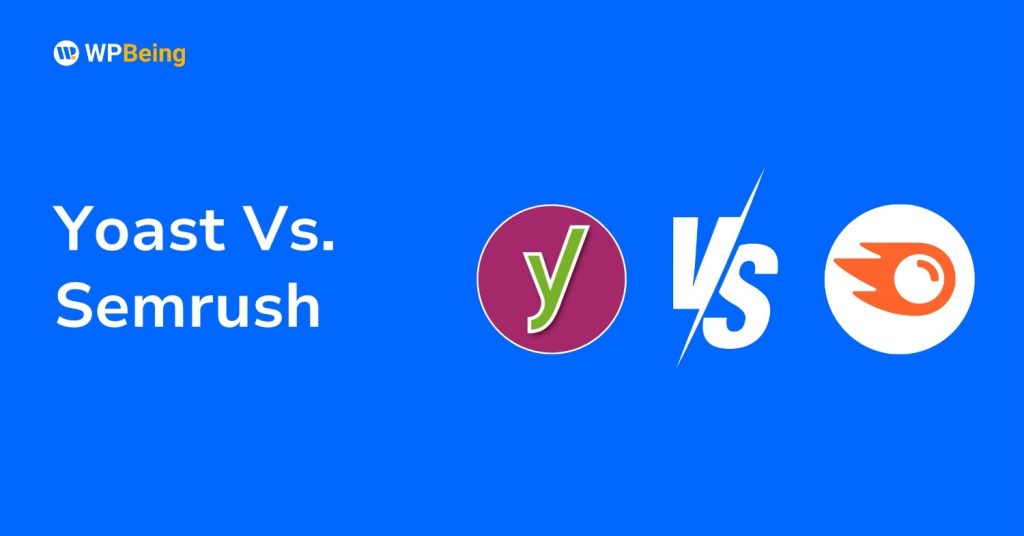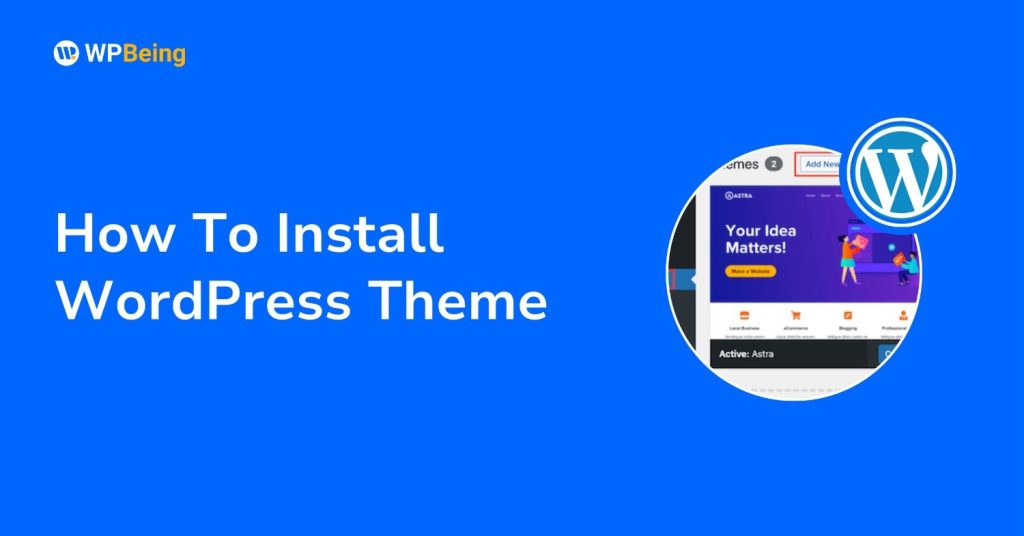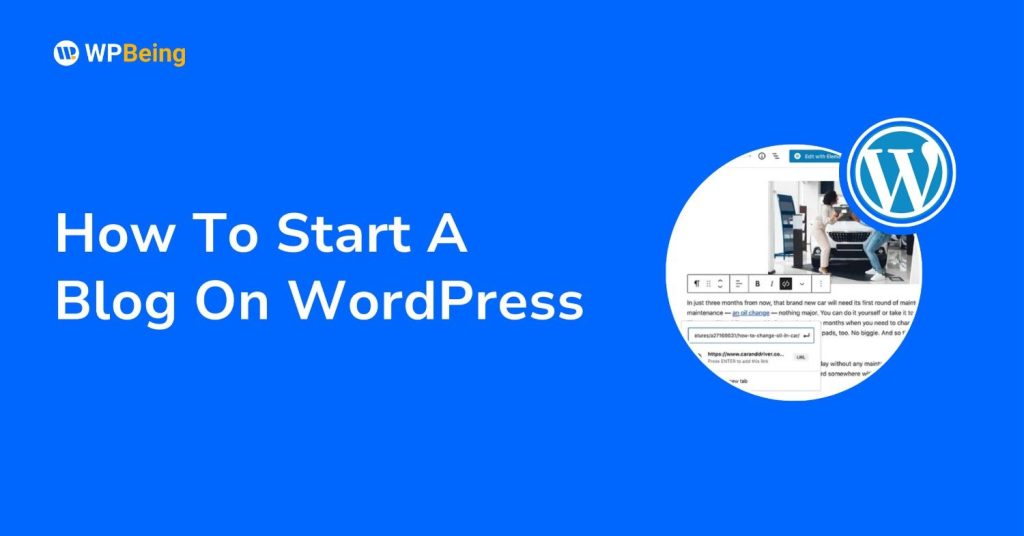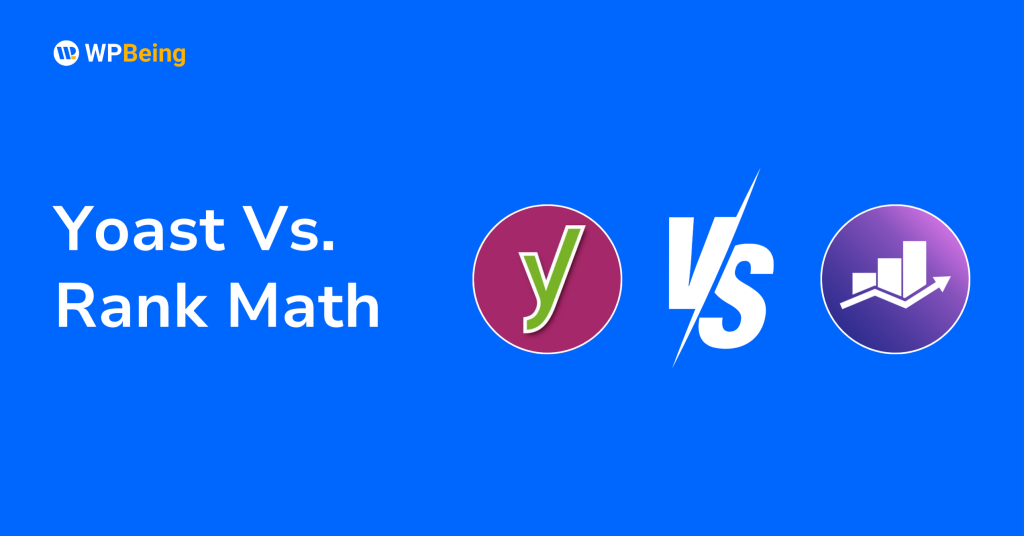The Indexing API is designed for pages with structured data related to job postings or live-stream videos.
It allows the website owners to notify Google directly when new content is added or removed from their site.
This helps Google discover and crawl new pages quickly, ensuring that fresh content appears in search results faster.
For sites that frequently publish short-lived content, like job listings or live streaming events, using the Indexing API can be beneficial in boosting their site’s visibility.
By pushing updates directly to Google, site owners can ensure their content remains fresh and relevant, which also drives high-quality traffic.
What Is Indexing API?
The Indexing API aims to help Google quickly discover, update, or remove content from its search results.
For example, if you publish a new job posting or start a live stream, you can use the Indexing API to tell Google to crawl and index the page immediately.
Similarly, if a job posting expires or a live stream ends, you can use the API to request that Google remove that page from the index.
This helps keep search results fresh and relevant for users.
The Indexing API only works for pages with schema types like JobPosting or BroadcastEvent embedded in a VideoObject. So, if your website has frequent updates in these categories, the Indexing API is a powerful tool.
You also need to specify the URL of the webpage you want Google to crawl, update, or remove.
Some things you can do with the Indexing API:
- Update a URL: Tell Google when content has changed or a new page is live.
- Remove a URL: Notify Google when a page is deleted so it can be removed from search results.
- Check request status: See the last time Google received a request for a specific URL.
- Send batch requests: You can combine up to 100 requests into a single call to make the process faster.
This API is handy for websites dealing with time-sensitive content like job openings or live events, ensuring that their pages appear or disappear from search results.
Who Should Use the Indexing API?
Google specifically says that the Indexing API is for websites like job postings and live streaming sites. Let’s take a look at a little info related to it:
- If your website has content that expires quickly, like job postings, event pages, or live stream videos, the Indexing API is your best bet.
- It helps Google discover and index your new content almost instantly, ensuring that time-sensitive information reaches your audience faster.
- This is especially useful for websites that rely heavily on fresh content that becomes irrelevant within days or hours.
Google wants to keep its search results fresh and needs a way to get rid of the old content from its uploader’s end. Read more about it here.
Who Should Use Sitemap Instead of Indexing API?
Websites whose content is not short-lived should use the sitemap instead of the Google indexing API:
- A sitemap is more suitable if your website has mostly evergreen content like blog posts, product pages, or service pages.
- Sitemaps help Google understand your site’s overall structure and ensure that all pages get indexed over time.
- A sitemap ensures that older static content continues to get indexed and stays discoverable in search results.
Note: Unlike time-sensitive content that may gain and lose traction quickly, evergreen pages benefit from consistent visibility, and a well-structured sitemap helps search engines recognize their long-term value.
Benefits of API Indexing on WordPress
API indexing on WordPress has changed the way search engines discover content. Instead of waiting for search engine crawlers to find your pages, you can now push your content directly for faster indexing.
Let’s look at some more benefits:
1. Faster Indexing
With API indexing, your content gets indexed almost instantly. You don’t have to wait for search engine crawlers to discover your page. This is especially useful for time-sensitive content.
2. Greater Control Over What Gets Indexed
You can decide which pages you want search engines to index and which ones to ignore. This helps keep irrelevant or low-quality pages out of search results.
3. Improved Accuracy in Search Results
Since API indexing allows you to provide structured data, search engines get a clear understanding of your content. This leads to more accurate and relevant search results for your audience.
4. Quick Content Updates
Whenever you update any content on your website, like your WordPress SEO strategy, you can immediately notify search engines through the API. This ensures the latest version of your content is reflected in search results without delays
Whenever you update any content on your website, you can immediately notify search engines through the API. This ensures the latest version of your content is reflected in search results without delays.
5. Reduced Server Load
Traditional crawling puts a load on your server as bots visit your site repeatedly. With API indexing, you directly push updates to search engines, reducing the strain on your server.
6. Ideal for Dynamic Content
If your website frequently updates content, like news, event listings, or job postings, API indexing ensures those changes appear in search results almost in real time.
7. Better SEO Performance
By ensuring your latest content is indexed quickly and accurately, API indexing increases the chances of ranking higher on search engine result pages (SERPs).
Switching to API indexing on WordPress can significantly enhance your website’s visibility and performance. It’s a smart move if you want your content to appear in search results faster and more accurately.
The Prerequisites for API Indexing on WordPress
Before search engines can index your WordPress site via an API, certain prerequisites must be met to ensure seamless crawling and data retrieval. Here’s what you need to have in place for effective API-based indexing.
1. Prove Your Site’s Ownership
First, you need to verify that you own the site using Google Search Console. You can either use the Domain Property method (like example.com) or the URL-prefix Property (like https://example.com or https://example.com/some/path/).
The Domain Property method verifies ownership of the entire domain (including all subdomains and protocols), while the URL-prefix Property verifies only a specific URL and its sub-directories, requiring separate verification for different versions (e.g., HTTP vs. HTTPS, www vs. non-www).
This step is necessary because Google needs to confirm that you have the authority to make indexing requests.
2. Grant The Owner Status To Your Service Account
After creating your service account, you need to give it ownership access. You can add it as a delegated owner (granted access without a verification token).
Go to Search Console > Select your property > Click Add an Owner > Enter your service account email (delegated owner).
Your service account email must have a format like:
my-service-account@project-name.google.com.iam.gserviceaccount.com.
This allows the service account to communicate with the Indexing API on your behalf.
3. Getting The Access Token
The access OAuth token is like a digital key that allows your site to communicate with Google’s Indexing API. You get the OAuth token in exchange for the private key.
The token is temporary and needs to be included in every API request. You can use Google’s API client library to generate the token to get OAuth tokens for various languages.
You can learn more about how to obtain the OAuth token and its requirements with the examples listed on this page.
Once you’ve completed these steps, your WordPress site will be ready to use API Indexing for faster and more efficient content indexing.
How To Use the Indexing API?
Ensuring that Google promptly indexes your WordPress content is crucial for visibility and search rankings. The Google Indexing API offers several methods to speed up this process:
1. Utilizing the WordPress REST API
The WordPress REST API allows developers to interact with WordPress from external applications, enabling custom solutions for various functionalities, including indexing. Here’s how you can leverage it:
- Develop Custom Endpoints: Create custom REST API endpoints that trigger the submission of URLs to Google’s Indexing API whenever new content is published or existing content is updated.
- Automate Indexing Requests: By integrating the Indexing API calls within these custom endpoints, you can automate Google’s notification process about new or updated content.
Note: Implementing this method requires a good understanding of both WordPress development and Google’s Indexing API.
2. Leveraging WordPress Plugins
For those who prefer a more straightforward approach without delving into code, several plugins can facilitate the integration of Google’s Indexing API:
- CrawlWP SEO: This plugin allows you to notify Google about your site’s pages and posts, prompting faster crawling and indexing. It supports both automatic and manual submissions.
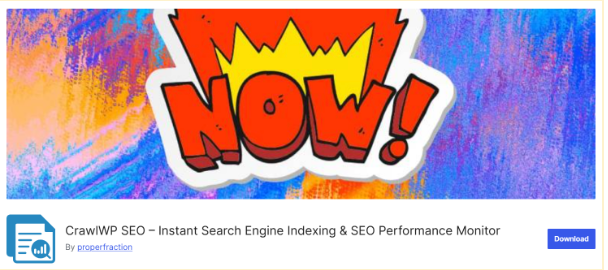
- Rank Math’s Instant Indexing: Rank Math offers an Instant Indexing plugin that utilizes Google’s Indexing API to get your content indexed quickly. It provides features like automatic submissions upon publishing or updating posts and the ability to remove posts from Google’s SERPs.

- Rapid URL Indexer for WP: This plugin integrates with the Rapid URL Indexer service to help get your website’s pages indexed on Google efficiently. It offers a pay-as-you-go model, where you only pay for successfully indexed URLs.

Important: Google recommends using the Indexing API primarily for Job Posting and Live Streaming websites. While these plugins can work on other types of websites, proceed with caution and ensure compliance with Google’s guidelines.
3. Implementing Custom-Coded Solutions
For developers seeking a tailored approach, custom-coded solutions offer flexibility:
- Direct API Integration: Write custom scripts that interact directly with Google’s Indexing API. This involves:
- Authenticating: Obtaining an access token to authenticate your API calls.
- Sending Requests: Notifying Google of new, updated, or deleted web pages by sending appropriate API requests.
- Automation: Set up automated processes to send indexing requests whenever content changes occur on your WordPress site.
Note: This approach requires a solid understanding of Google’s Indexing API and secure coding practices to protect your site’s integrity.
By choosing the method that aligns with your technical expertise and site requirements, you can effectively utilize Google’s Indexing API to enhance your WordPress site’s visibility and search performance.
4. Requesting Approval & Quota
When you first start using the Indexing API, Google gives you a default quota to test things out. This means you can send publish requests for updating or deleting URLs without any issues.
But if you plan to send a lot of requests (like submitting thousands of URLs), you’ll need a higher quota. To increase your quota, you simply have to fill out this form provided by Google. Once approved, you’ll get a higher limit.
You can always check your current quota by heading over to the Google API Console. And here’s the good part: using the Indexing API is absolutely free. So, no hidden costs!
5. Sending Requests
If you have a large number of URLs to index or remove, batching your requests is a smart move. You can combine up to 100 requests in a single batch, reducing the number of HTTP connections your client has to make.
This not only speeds up the process but also ensures you stay within your quota limits without overwhelming the API.
So, if you’re planning to push a ton of content to Google, batching is definitely the way to go!
Can I Use the Indexing API For Any Kind Of Website?
The Google Indexing API isn’t a one-size-fits-all tool. It’s designed specifically for the pages featuring job postings or live-streaming videos.
So, if your website doesn’t have this type of content, this API isn’t the right fit. For other content, it’s best to stick with traditional indexing methods, like sitemaps and regular crawling.
According to feedback on the WordPress Forums, take a look at what a user has to say about the same:
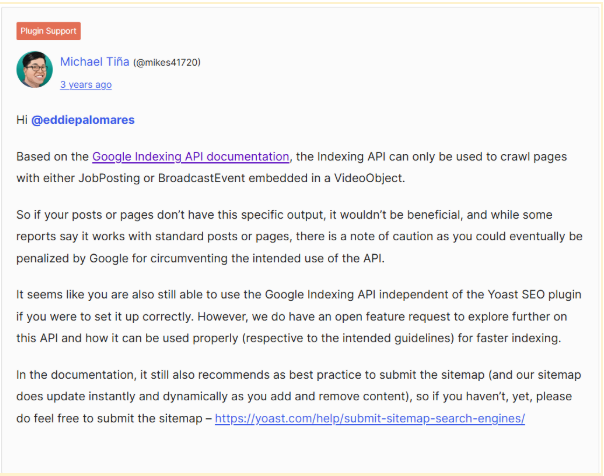
As Michael points out, some users say it works with normal posts or pages, but there is no guarantee that you won’t be penalized by Google. In this case, it’s better to be safe than sorry.
Best Practices For API Indexing On WordPress
To ensure your WordPress site is effectively indexed by search engines, follow these best practices:
- Prioritize Important Pages: Focus on submitting new or updated content like blog posts, product updates, and time-sensitive information.
- Use the Indexing API Responsibly: Avoid bulk submissions; notify search engines only about significant changes or new content.
- Implement Structured Data: Enhance your site’s visibility by adding schema markup to your pages.
- Monitor Indexing Status: Regularly check your site’s indexing status using tools like Google Search Console to identify and resolve issues promptly.
Popular Indexing Plugin
For sites with structured data related to job postings or livestream videos, the Instant Indexing for Google by RankMath plugin can be beneficial.
However, it’s recommended to use this plugin only for specific content types like job postings or livestream videos, as per Google’s guidelines.
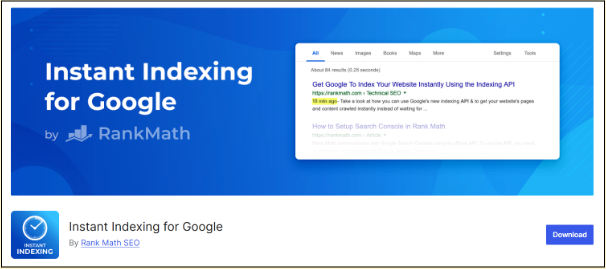
Adhering to these practices and using appropriate tools can enhance your WordPress site’s indexing efficiency and search engine visibility.
Guidelines
Even though you’re using the Indexing API, Google’s spam policies still apply. This means you should only submit content that follows their guidelines; otherwise, your site might get penalized.
Another thing to note is that you can only submit one URL per update request. However, you can batch up to 100 requests in one go. This helps you reduce the number of API calls, making the process smoother.
The two types of requests you can make are:
- Update URL request: This is when you want Google to index new or updated content.
- Remove URL request: This is when you want Google to de-index a URL from search results.
Each request will require two things:
- URL: The link to the page you’re submitting.
- Type: Whether it’s an update or removal request.

Related Reads:
Conclusion: Job Posting And Live-Streaming Websites Can Use Google’s API Indexing On WordPress
The Indexing API on WordPress is useful for websites that regularly publish job postings or live-stream videos.
It helps Google find and index such content faster, ensuring it appears in search results without delay. However, if your site mostly shares blogs or product pages, using a sitemap is a better choice.
To make the best use of the API, it is best to follow Google’s rules and only submit relevant content. This way, you can keep your site updated in search results without any hassle.
FAQs
Your site may not be indexed due to incorrect WordPress settings, issues with robots.txt, a faulty sitemap, low-quality content, technical errors, or a lack of backlinks, preventing search engines from crawling it properly.
Indexing is beneficial as it allows your website to appear in search results, driving organic traffic. Without indexing, your site remains invisible to search engines and potential visitors.
API indexing enables website owners to notify search engines directly about new, updated, or removed pages via an API, ensuring faster and more efficient indexing.
An API (Application Programming Interface) allows applications to communicate and share data, features, or functionality, enabling seamless integration between different software systems.

